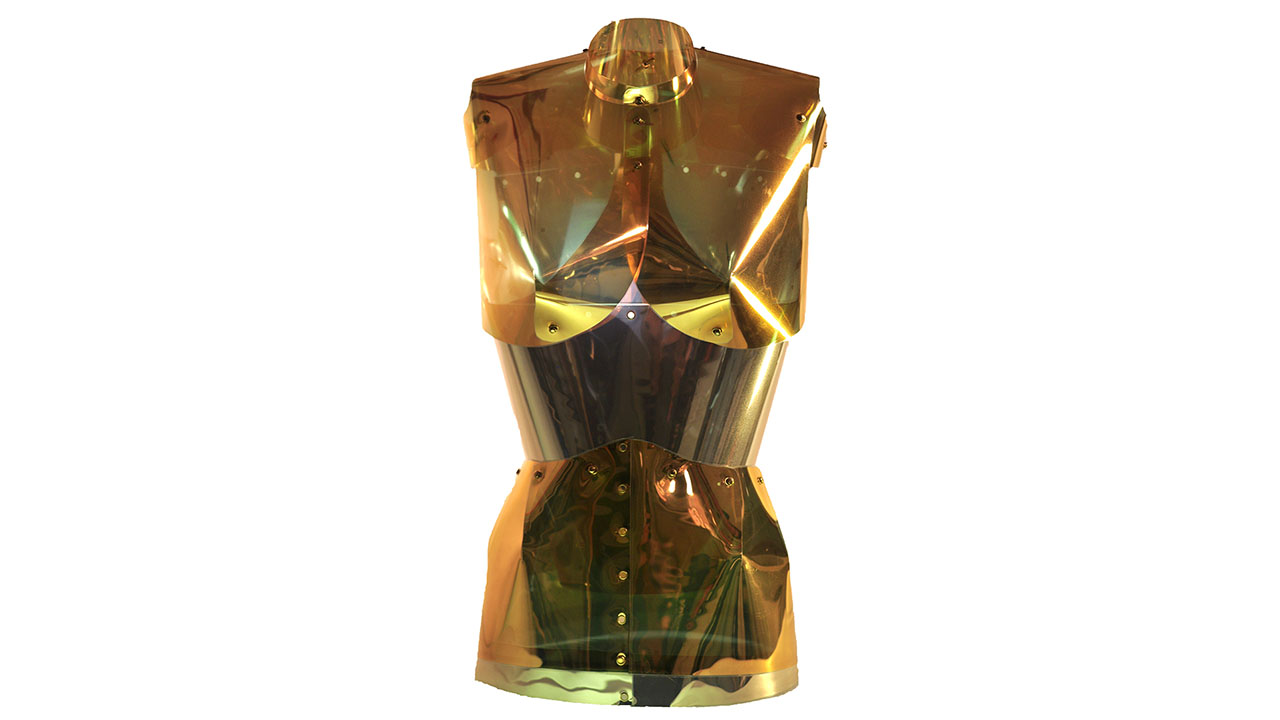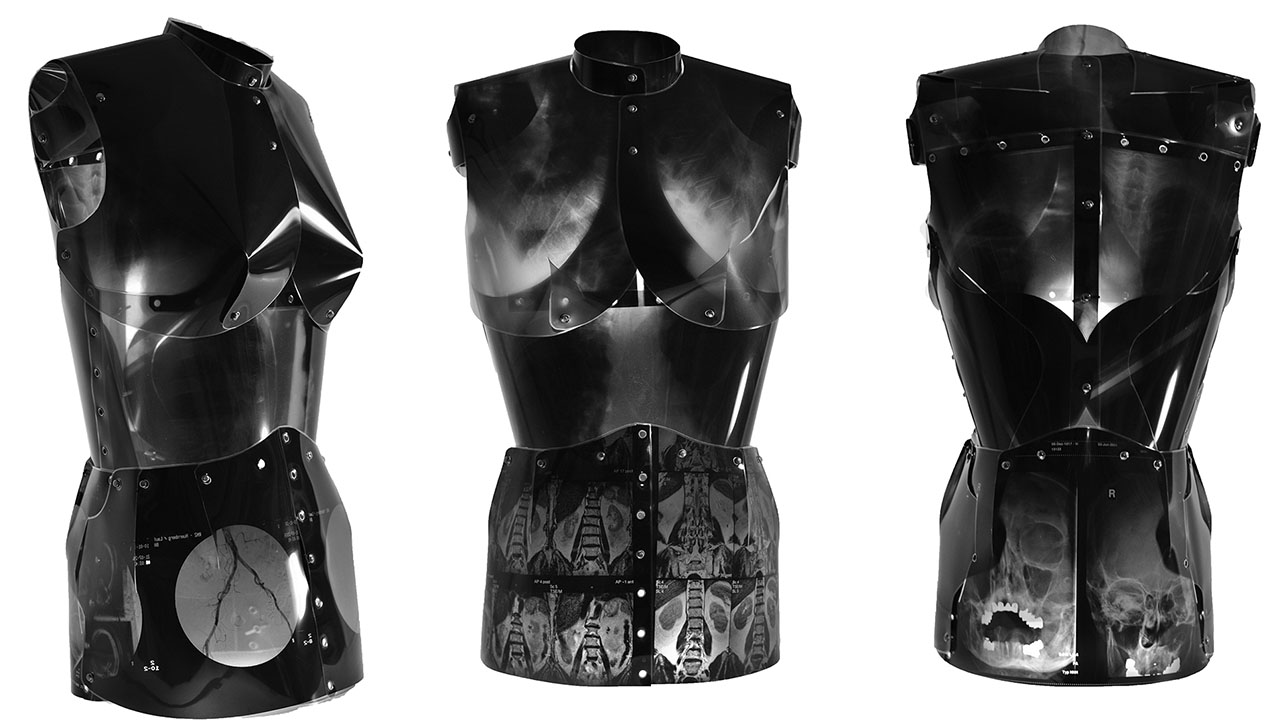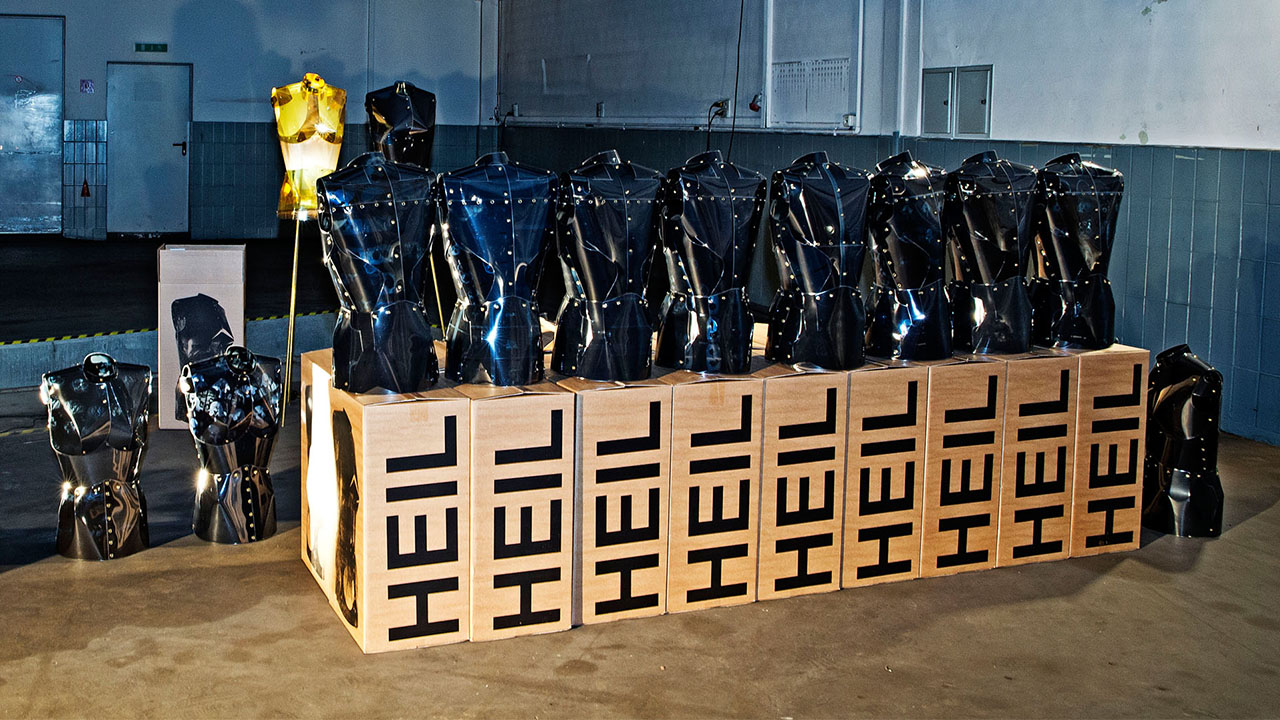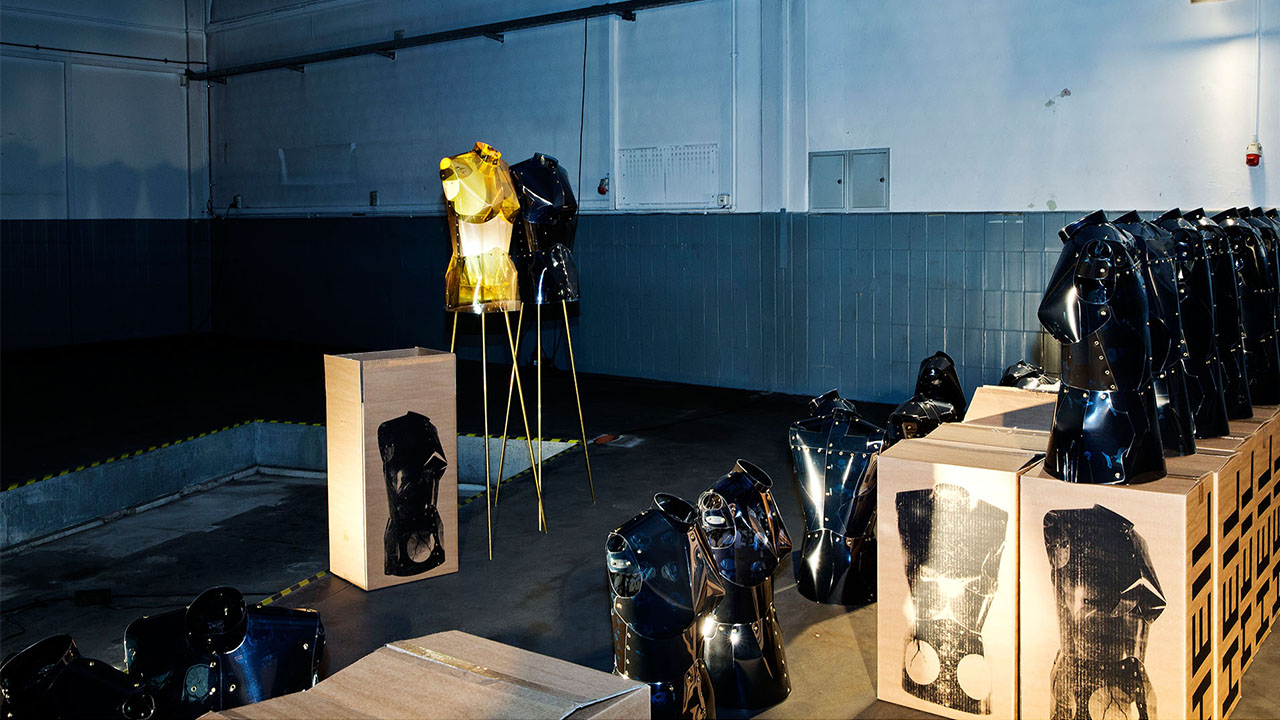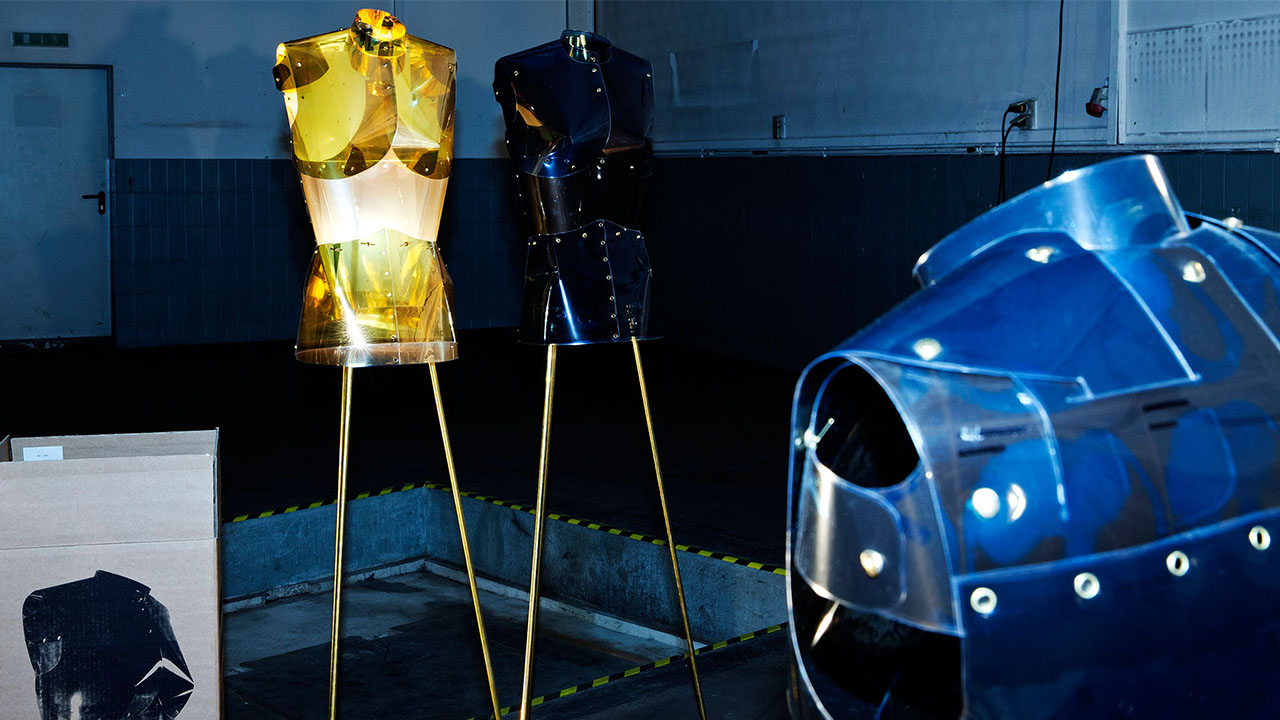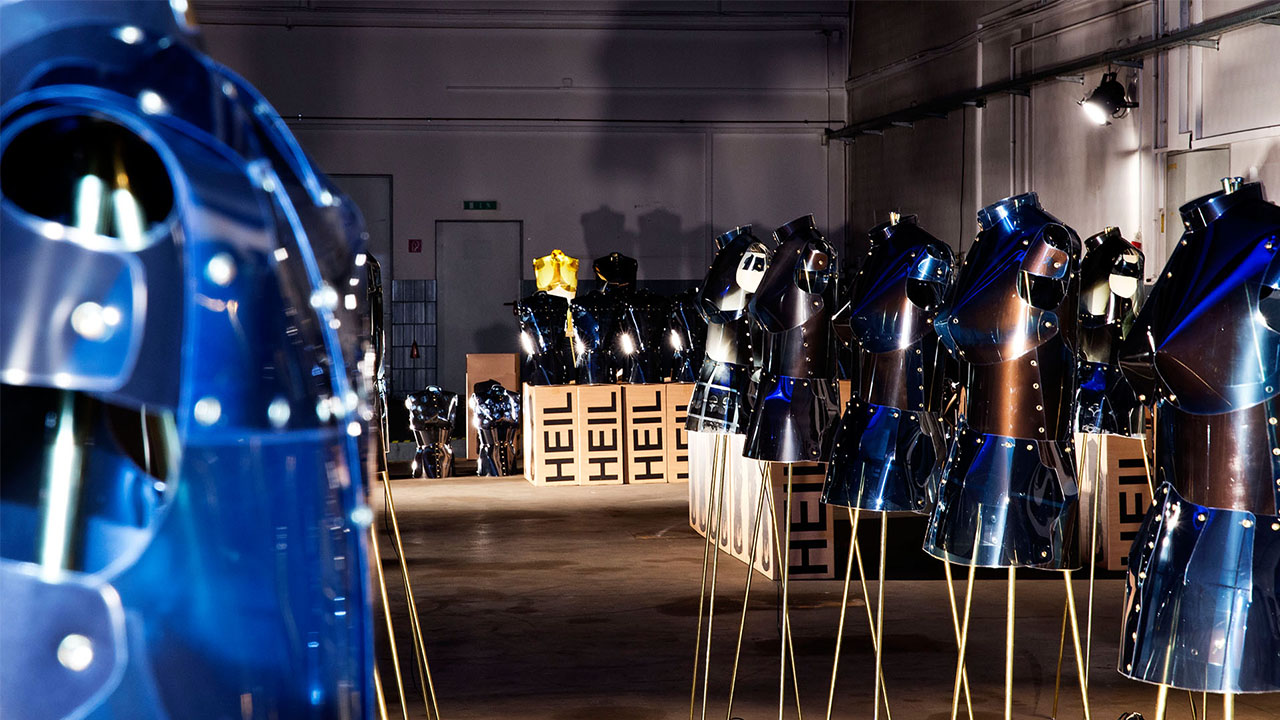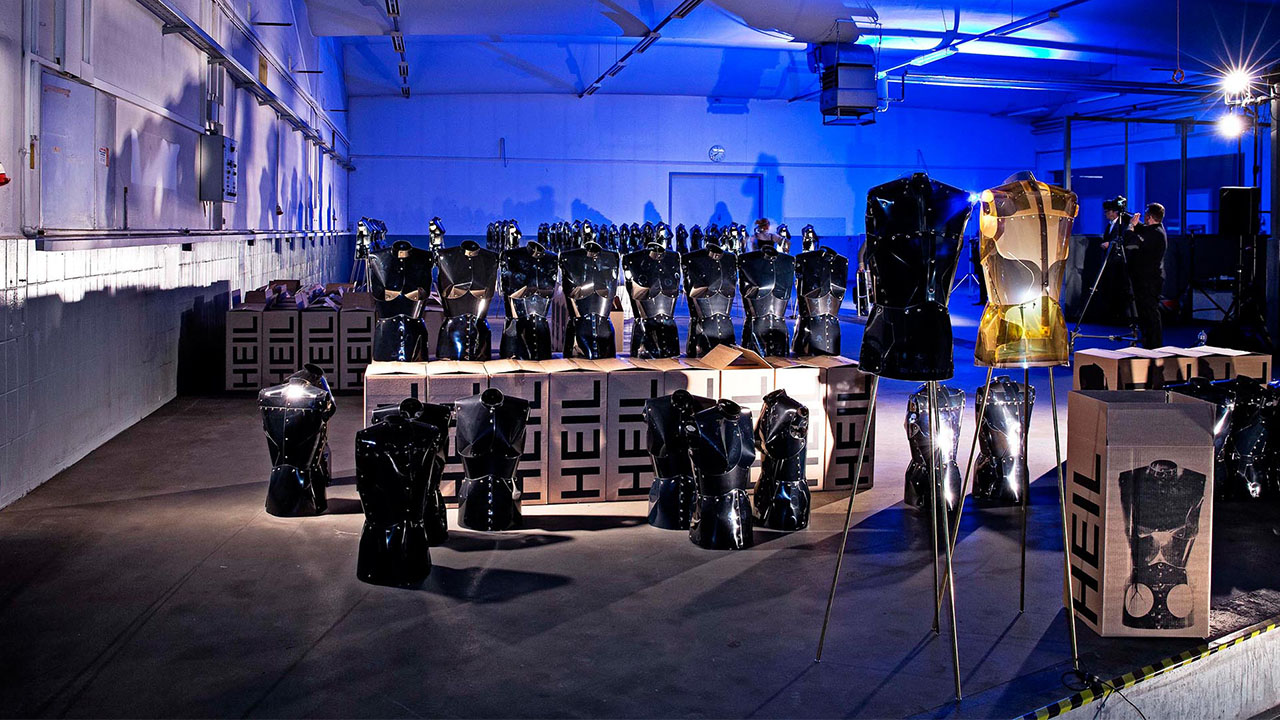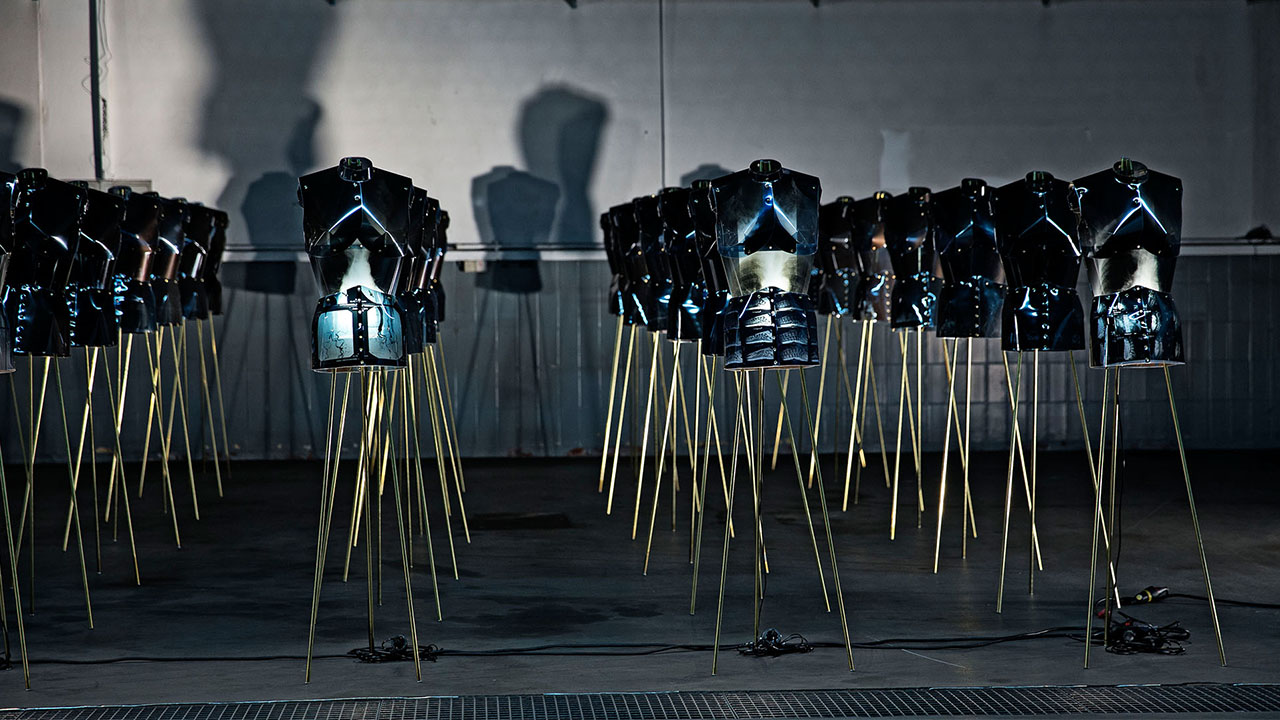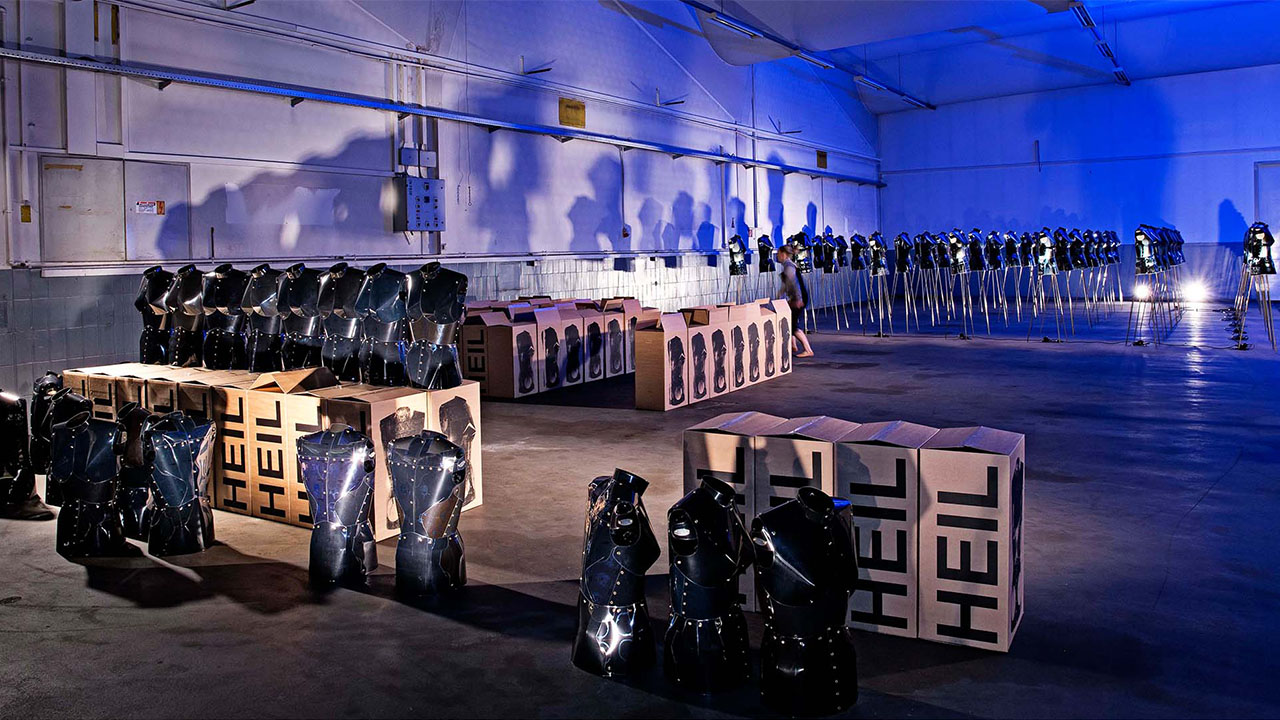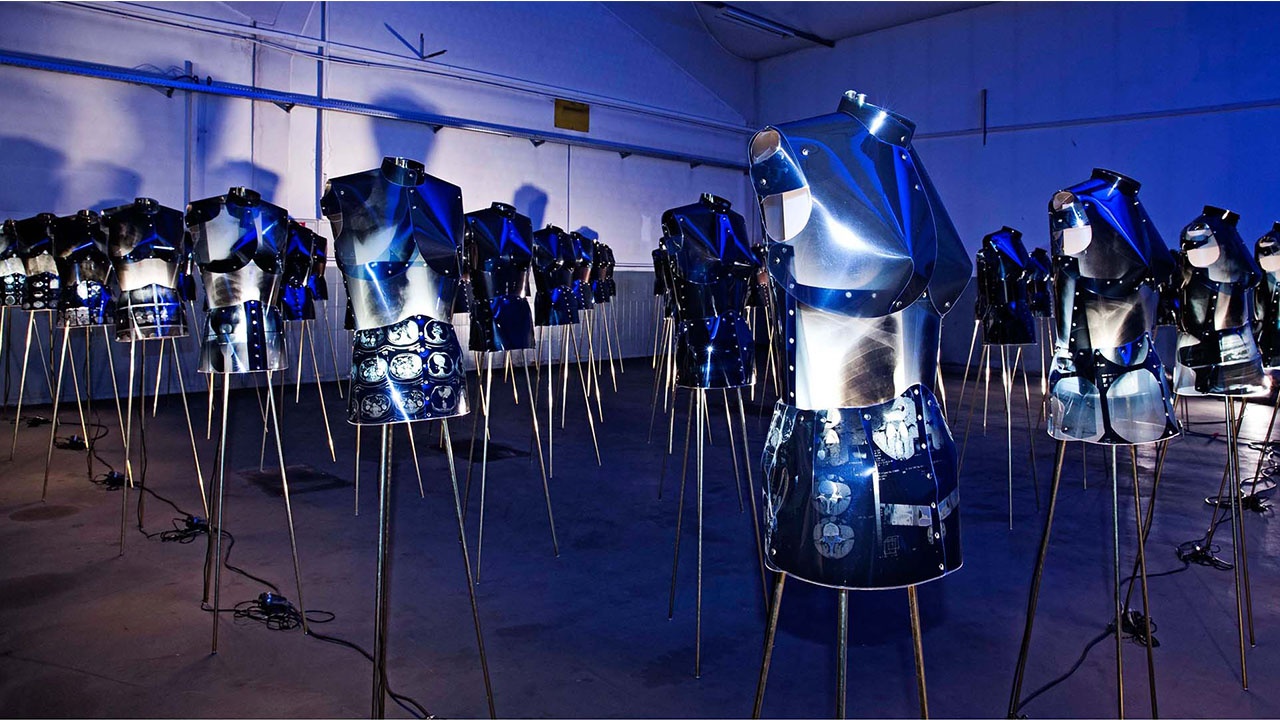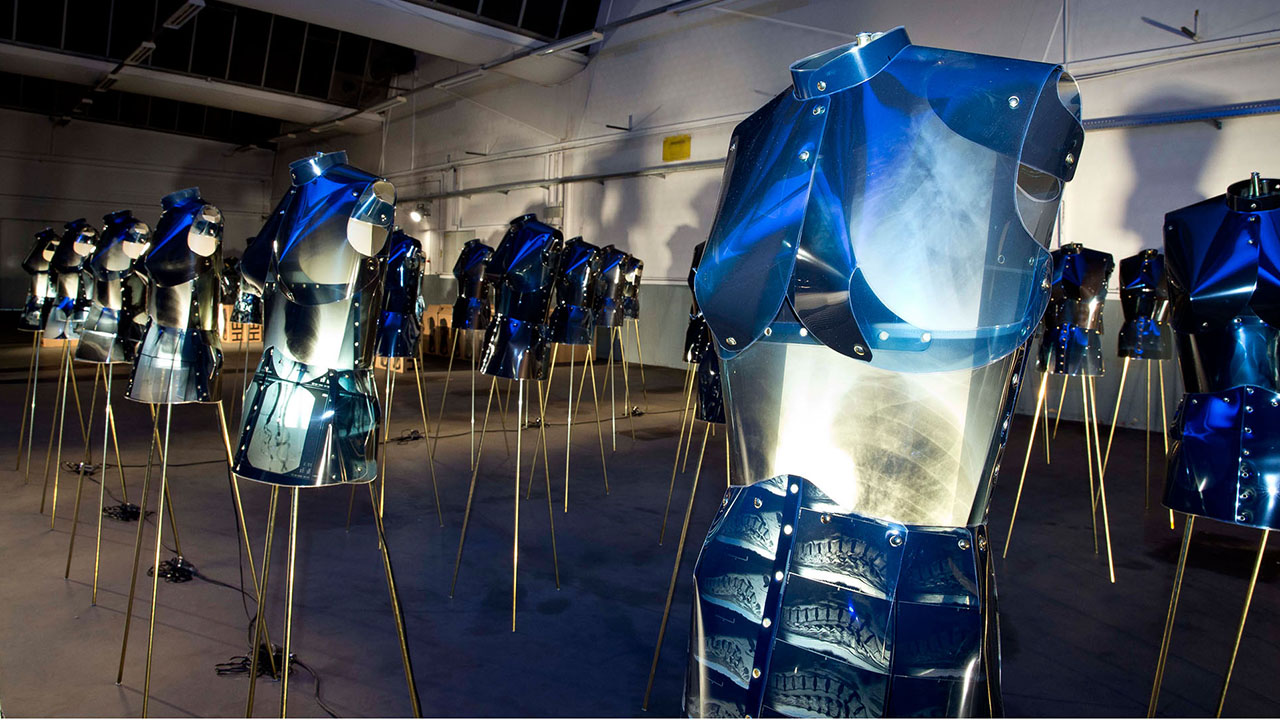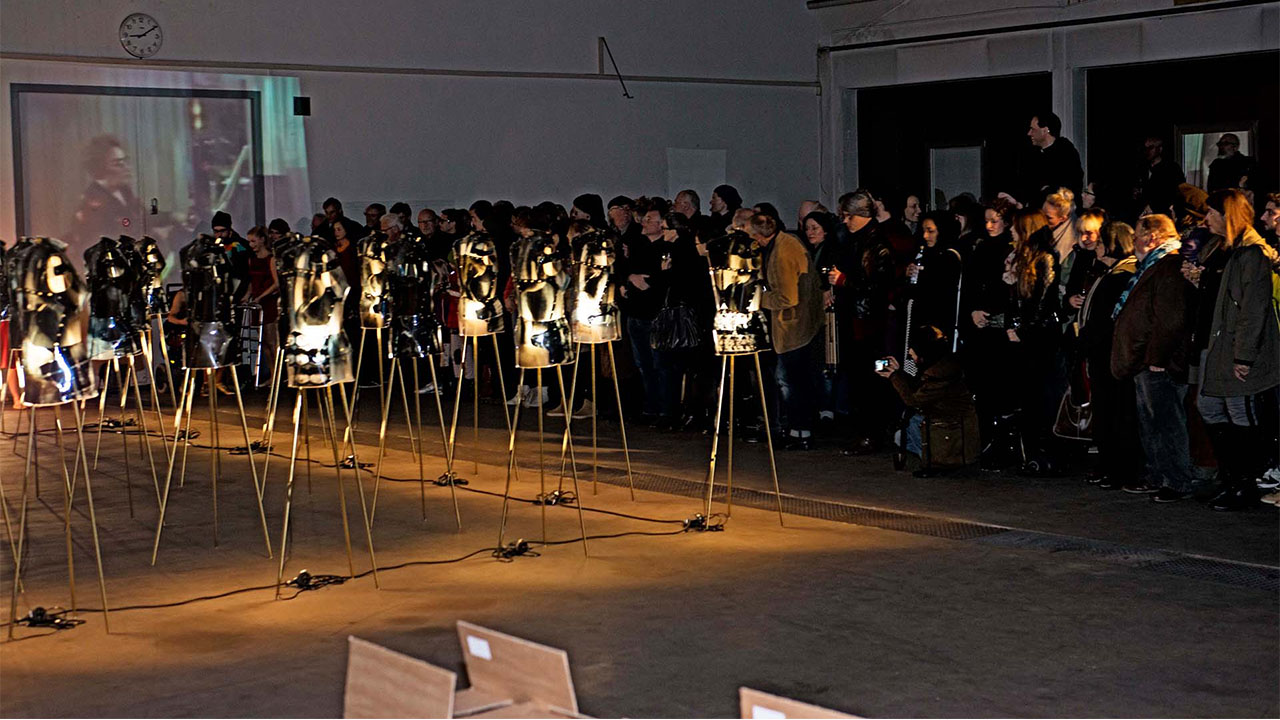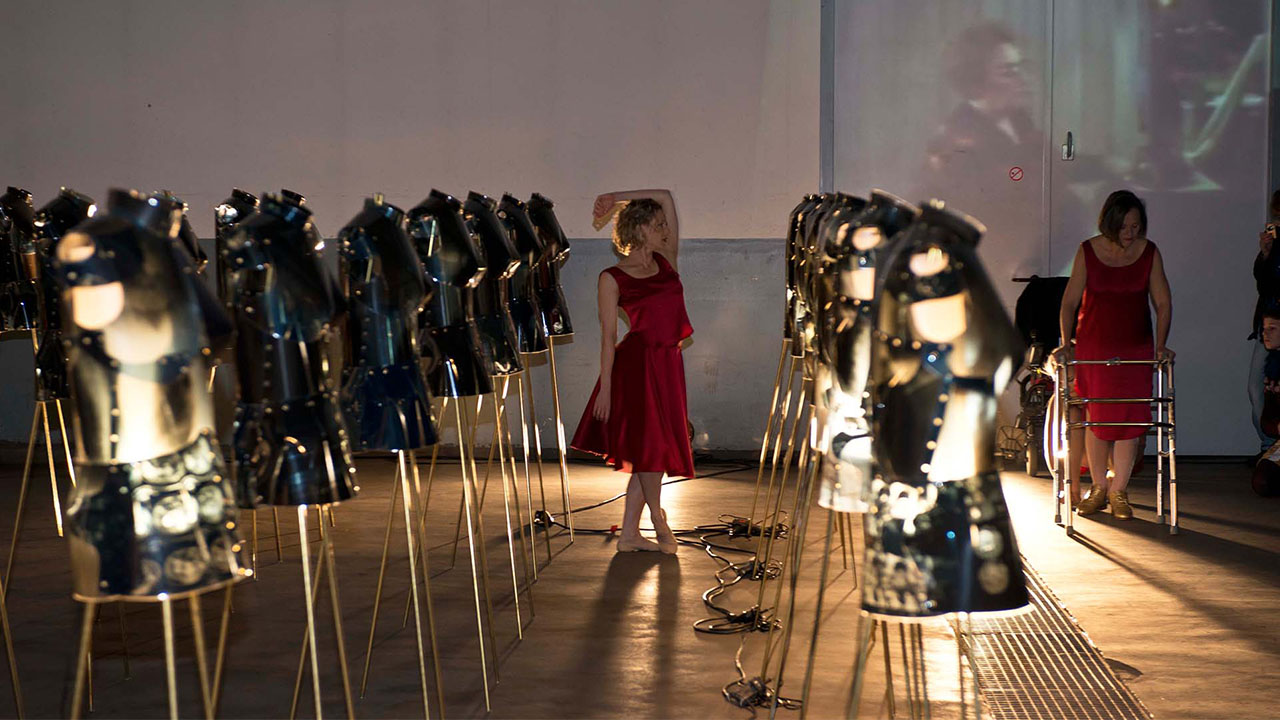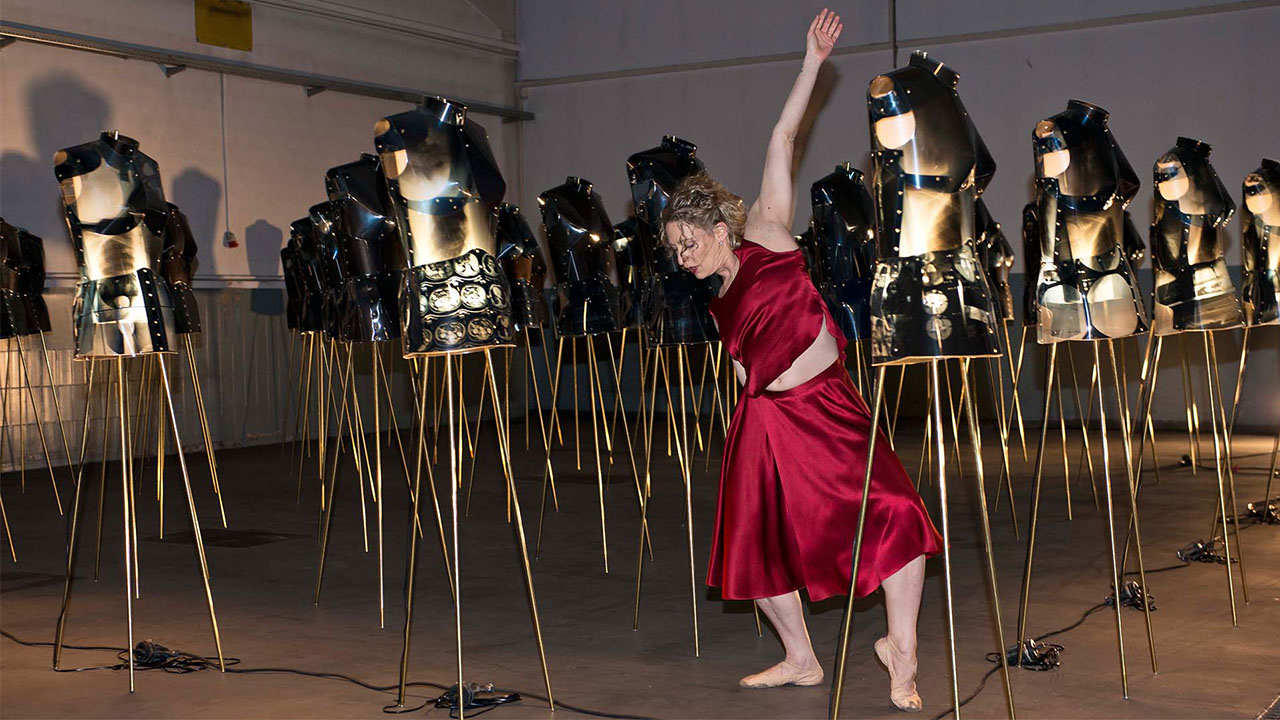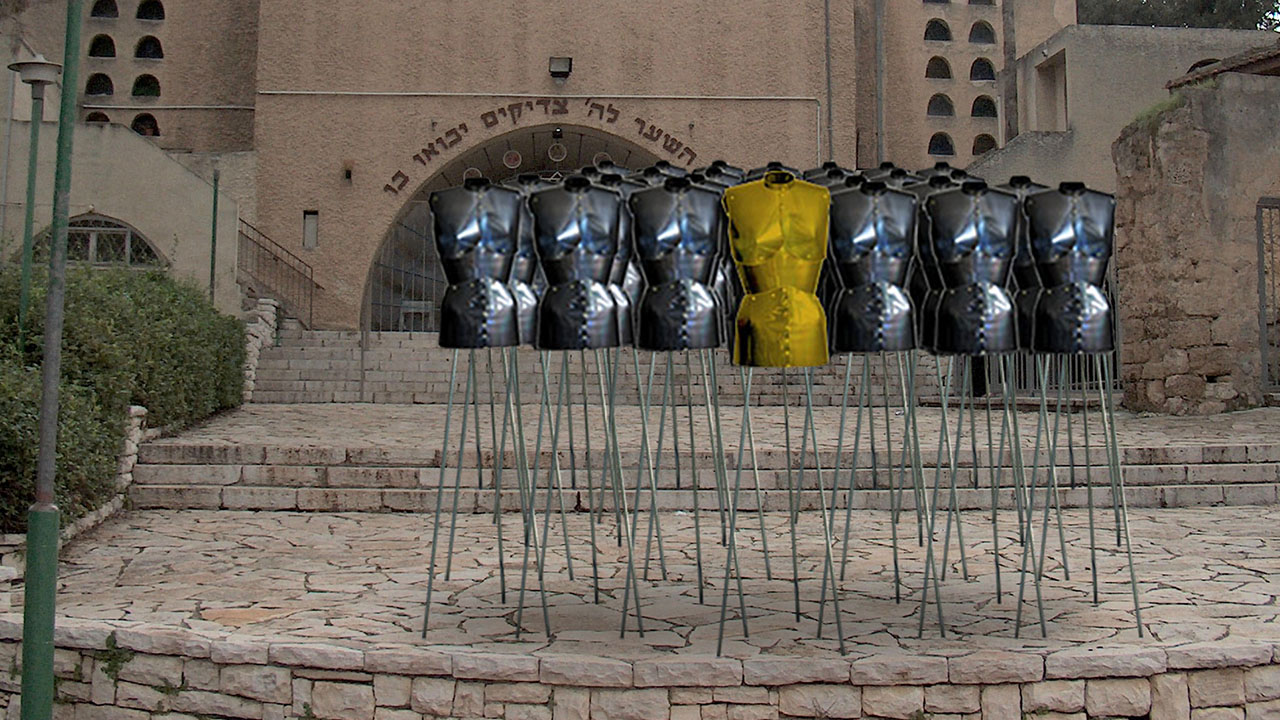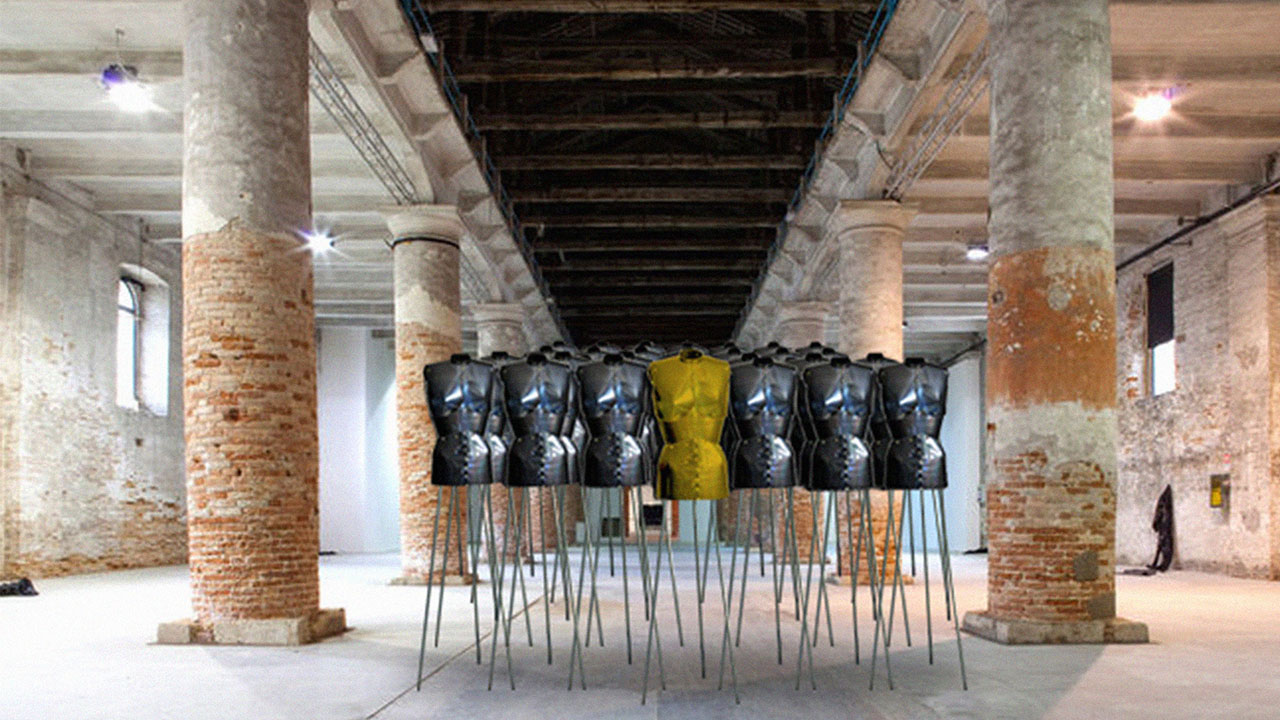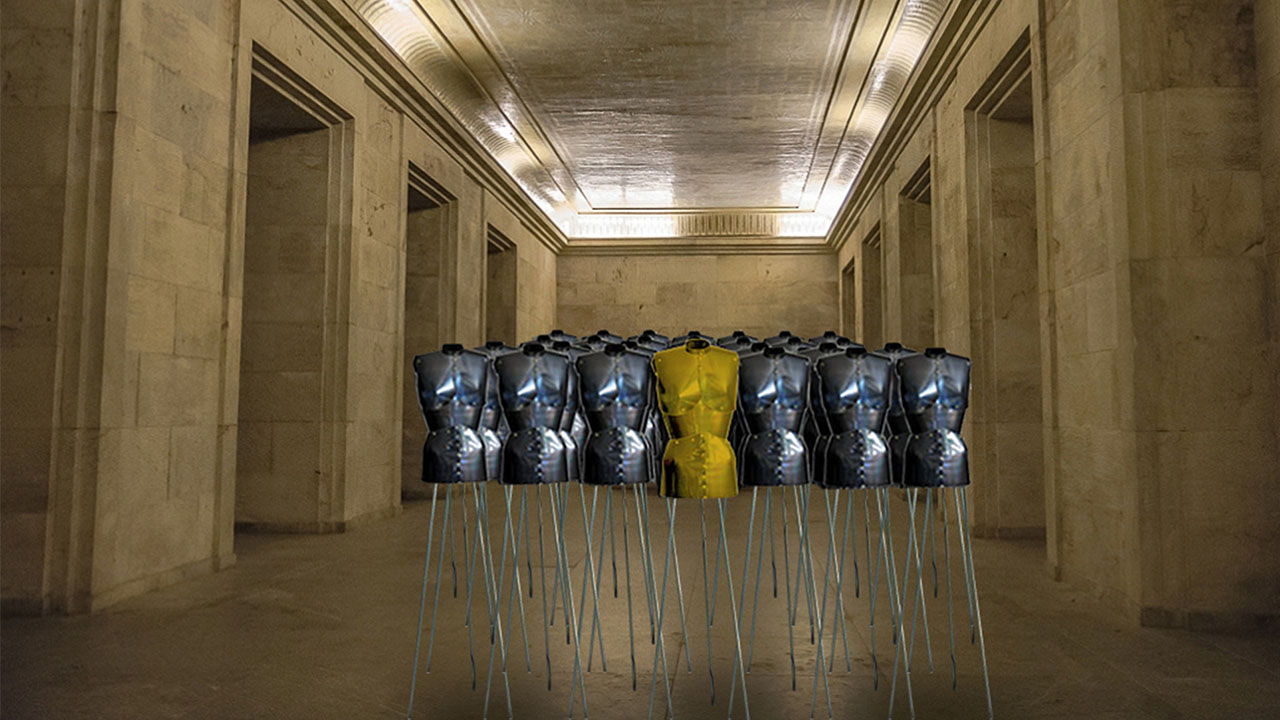70 torsos made of laminated X-ray images + 1 torso made of pure gold
Borgo Ensemble Nuremberg, October 2015
Photographs by Walter Schneider and Michael Zirn, http://www.michael-zirn.de
"Synonym“ von Nora Gomringer, freie Schriftstellerin
zur Arbeit der Bildenden Künstlerin Eva Brenner „HEIL“
In 1895, Wilhelm Conrad Röntgen discovered the possibility of looking inside the body with the help of electromagnetic waves and discovering bone fractures, foci of inflammation, atrophies or growth forms, anomalies and the statistical norm. His insight became the medical insight of an entire century. The "X-rays" named after him (German: “Röntgenstrahlen”, translator’s note) hit almost every person in the so-called first world once - if not many times more - in the course of a lifetime.
What usually remains of the insight and view is a factotum, an X-ray image. Still captured today on foils of a certain light green colouring, the patient's interior results in "a two-dimensional representation of a three-dimensional matter". This is how Eva Brenner describes it, who has been fascinated by this logic for many years.
The visual artist is a wheelchair user. The fact that I am not writing here that Eva Brenner sits in a wheelchair is the result of my encounters with this thoroughly impressive and extremely active, mobile woman. Sitting is too passive for an artist who, despite her seated position, meets the art market at eye level and discusses and competes shoulder to shoulder with the "players" of the regional - she lives in Nuremberg - and international scene. For a while I wrestled with myself whether to describe Eva Brenner in this text, whether her MS disease, which leads to increasing restrictions in her movements, plays a role, but the artist herself offered the answer in a conversation: "It seems to me as if I am body-blind. As if my mind has not realised that I am a human being in a body that has to accept various changes. Mind, soul and senses are awake and agile." Living in this dichotomy, Brenner's art is biographical but not strictly autobiographical.
Certainly, the artist's multi-part work "HEIL", through this information, now charges itself with meaning in a different way. More knowledge opens up more of the world to us. It’s very likely, a clever mind has already expressed this in either this or a similar way. Nevertheless, this text wants to achieve more more than openly address an artist and her work. It wants to show the conceptual world of Eva Brenner, who works as an artist and thus reflects to the world the issues it deals with constantly or not enough.
But what is "HEIL!"? According to rhetorical doctrine, it is artful at this point to answer with the counter-question: What is it not? First of all, in the German language it is a word, an adjective, opening up the question of the state of something. It is not broken, so it is whole (German: “heil”, translator’s note). It is complete, not broken down or even violently shattered into individual parts. The Latin "salus", the salvation, speaks from it. A physician would put it differently than a philosopher. Holism, wholeness, as the deepest trait of nature, physical integrity and yes, medically considered health - a functioning of all bodily processes with simultaneous freedom from pain and restriction, this is the Latin and probably the universally desired salvation (German: “Heil”, translator’s note). The salvation of the soul is also in the lexical field. The great world religions redeem through the doctrine of the Passion in life to eternal salvation, sometimes assumed to be in a barely defined paradise. When greeting Caesar in his time, the legendary Roman general and later emperor of the vast Roman Empire, the speaker used the formula "Ave, Caesar!" which today is translated as "Hail, Caesar!". And it was from this formula that Adolf Hitler also claimed the Hitler salute. "Heil, Hitler!", combined with a corresponding gesture and the heel-cracking of the uniformed men, resounded devastatingly through war-torn Europe in the 1930s and 1940s. Those who are still demonstrating association with Nazi ideas today bring the Hitler salute with the articulated wish for salvation for the dead criminal into the public space. There, the officially banned salute continues to spark discussion and insecurity. The democratic structure has been tested for its tectonics and found to be stable since 1945. Words and gestures can supposedly no longer harm us. And yet...
The word "heil" triggers precisely these questions about tectonics in a language worker like me. How is our language layered, how has its use been layered since its abuse or in its ongoing abuse? Which meanings overlap, are deposited, become obsolete, disappear, are dispensable, reappear - believed to be past? Which words are memorials, triggering consternation, memories, questions with answers that lie within, now and for a long time to come? Ill, the opposite of heil (“healthy”), alarms to a similarly drastic extent.
HEIL by Eva Brenner is a contemplation with simultaneous confrontation with the word in its literal as well as figurative sense.
49 torsos, designed according to the artist's measurements, stand as a phalanx in the room, forming a front of tripods, of headless bodies. The master tailor Eva Brenner has dressed her torso avatars with her own and other people's X-ray images, rather the rigid foils riveted together reproduce the body shapes and the vital suddenly turns into decorative ornament. The more broken the bones on the photos, the more extravagant the effect. Image becomes dress, dress carries meaning, meaning becomes statement. Each torso is given an identification number on a golden plaque around its neck. Even avatars, for all their individuality, want to be kept track of. They are delivered in the boxes designed for them with the mighty lettering, modelled on Warhol's Brillo boxes, which leaves no doubt: Heil is being touted here. Uniformity with simultaneous individualisation is a theme that gets as much under the viewer's skin as mass effect and staging.
A second group of 22 figures is located near the 7 × 7 torsos. They are used to re-enact Francisco de Goya's " The Third of May 1808 ". A torso in pure gold, illuminated, stands to the side of the viewer, opposite him with his back to the audience are 8 fusiliers. In this group, Eva Brenner’s avatars are marked with an identification number on a silver label on the right upper arm.
The painting from 1814, on which the artist has based her work, has become a symbol, literally synonymous with the condemnation of violence and counter-violence, and has found numerous imitators in art history. The artist herself cites Manet's, Dix's, Picasso's and Yue Minjun's interpretations as influential in the reception of the topos.
With the second group, direct historical reference comes into the large-scale installation and the demand for justice and moral courage, addressed to the generations of the future. The consideration of the first group allows for much more general thought around the tragedy of categorisations. Heil (“healthy”) or ill, that was Nero’s thumb and decided in times of National Socialism whether life was worth living or being killed, solely in order - as it was hair-raisingly formulated - to keep the entirety of the national body healthy.
As a viewer, moving around two bodies of work that make disability their subject, yet operate under a different name, namely "healthy hand", is a deliberate confusion that the artist knows how to play with elegantly. An artist who - as described - has developed an expertise on the subject, as one would think. Since Brenner herself has disability as a life theme, it is painful, even directly painful for those who are not equally affected, to experience the direct confrontation. This results in a transmission error that is all too common in literature: author becomes protagonist. Or as here: Author becomes representation. Once one has fallen into this trap of thought, one must free oneself from it, otherwise one's own contemplation will end in the dead end of pity and the transfer to one's own sphere of action ceases to exist. It would be too easy that way!
Health is a difficult state to define. Illness is easier. Your gut feeling itself tells you that something is wrong. We are healthy when everything is good and rare are the moments when we register with satisfaction that everything is in order, we are healthy, free of pain, The HEIL (“health, wholeness”) of Eva Brenner’s fragmented bodies, which are only determined by serial order for stability in the collective, take their place as admonishers. The very use of the term in a German city, and moreover in Nuremberg, where the National Socialist racial laws were passed, is still a provocation. All the presumption of judging what can be considered HEIL inflames society again and again, because it is an intimate whole, the completeness.
Where these mute admonishers march up and give even a woman's body a multiple appearance, everyone is called upon to take a stand. And this is a mindset. And so we are linguistically specific. No one can be left out, whoever is here has life and - according to Christian doctrine – Heil (“salvation”) is: life.
When Eva Brenner's work was first described to me, I was reminded of the description of the witch
Xaide's troops from Michael Ende's "The Never-Ending Story", who, solely moved by the willpower of their mistress, perform services. Thoughts of the Golem theme get in our way, the lack of will and
the simultaneous desire for leadership of the individual in a mass of people, democracy and
dictatorship, wholeness and division, recovery, illness and healing, the need for protection and the
needs of the individual in the crowd. Thoughts meander, I am threatened and fascinated by
Brenner's bodies. And I am recognised. HEIL endures all these considerations. As a staging and
installation in which the artist, in the context of an event, moved, danced herself, showing her own
body, thus joining the ranks of her admonishers, Brenner gives us an unwritten manifesto of
wholeness, of being damaged and unharmed, of HEIL.
http://nora-gomringer.de
HEIL von Norbert Pfaffenbichler,
Künstler, Filmemacher und Kurator
Heil Hitler, Sieg Heil, Berg Heil (greeting among mountaineers, translator’s note), Un-heil (German: „harm“, translator’s note), Heil-ung (German: „healing“, translator’s note), heil-sam (German: „curative“, translator’s note), heil-ig (German: “holy”, translator’s note) , ... The chain of associations triggered by the word "Heil" is probably unique in the German language. The range extends from extremely negative terms to very positive connotations. Such a title for an artistic work cannot be understood but as a provocation. The word has been globally discredited for all time by its notorious use as a greeting in the SS regime. The artist Eva Brenner puts it in capital letters and uses a "bold" font. The typography virtually "yells" the title metaphorically into space.
Eva Brenner (*1963) lives and works in Nuremberg. This medieval city wrote itself into the history of the Third Reich primarily through the so-called "Nuremberg Rallies". This achieved worldwide fame not least because of the propaganda film by Leni Riefenstahl (1902 - 2003). The "Nazi party rally grounds" designed by the architect Albert Speer (1905-1981), are used today as a documentation centre, among other things.
In 2014, the artist began constructing sculptures from numerous X-ray images taken of her own body. The trained costume designer assembled the transparent foils into figurative assemblages, cutting and riveting the elastic images together. She placed each of the resulting asexual torsos, which are also reminiscent of tailor's dummies, on three extra-long metal poles. Later, Eva Brenner also began to work with X-ray images of other people, which she was able to acquire from an abandoned doctor's practice.
She uses the motifs on the x-rays purely ornamentally and not according to the body scheme; lungs sit on hips, skulls on chests, knees on backs, etc. The colourless images from the inside of human bodies simply serve as (fabric) patterns for the hollow shells. The fragility and vulnerability of human physiology is literally brought to the outside. Surprisingly, the effect of these fragile objects is by no means macabre or sinister.
X-rays are usually taken when parts of the body are injured, when the unity and integrity of the body is no longer given. In addition X-rays always show only certain sections and never a whole human body. Eva Brenner collages the fragmentary images of fractures and other injuries into new units, into schematic and standardised body shells. Each of her figures is unique and in order to emphasise or counteract this individuality, the artist attaches identification numbers to the neck of the torsos.
To date, Eva Brenner has produced a total of 71 life-size figures, which she divides into two ensembles. The first group forms a regular square grid of 7 x 7 figures standing at attention, lined up in rows. It is no coincidence that this hermetic phalanx is reminiscent of a military formation. Killing and injuring is probably one of the core tasks of any army. This ghostly army is made up of the disabled, the wounded and the patched up, of headless trunks and uniforms as stiff as they are hollow.
The second formation of 22 figures is a re-enactment of Francis de Goya's (1746 - 1828) painting "The Third of May 1808 ". This iconic work has often been paraphrased by artists such as Eduard Manet, Otto Dix, Pablo Picasso and many others, but never before so coldly, schematically and de- individualised as by Eva Brenner.
The supposed delinquent condemned to death stands out from the ensemble. This figure is made of pure gold and stands in direct opposition to the others. The firing squad is lined up in a linear fashion with their backs to the audience. Other torsos stand and lie on the floor. In addition, brown packing boxes are set up, bearing the titular lettering "HEIL". These screen-printed boxes represent another art-historical reference, namely to the Pop Art legend Andy Warhol.
An installation of the walk-in constellations of figures in the so-called "SS Barracks" in Nuremberg, as envisaged by the artist, would be simply brilliant. The former barracks are also in the immediate vicinity of the Nuremberg Office for Migration. Eva Brenner's room-filling installation spans an associative arc from a traumatic past to an uncertain present and an uncertain future. The wounds and injuries from inside the body literally become the "(raw) material" for disconcerting uniforms, for shiny body armour and empty exoskeletons.
The martial formations of the ensemble of figures and the provocative title of the work are
unmistakable references to the Nazi reign of terror and the Second World War. Social healing
processes can only be set in motion by confronting the past, even if this is painful and burdensome,
and art has always made an essential contribution to this by provoking and putting its finger on
unhealed wounds. Eva Brenner's installation is equally captivating on the aesthetic level through its noble execution, as well as conceptually through its multiple historical, social and political references. Josef Beuys’s (1921- 1986) call to "Show your wound" is multiplied, as it were, in this ensemble of “figures of pain", injuries appear wherever one looks. A helpless army of headless and armlessvictims stands metaphorically for the pain of the individual as well as that of society.
http://www.norbertpfaffenbichler.com
